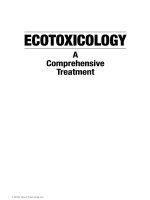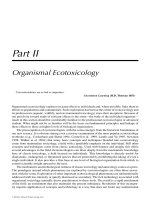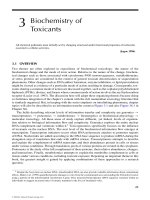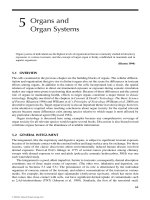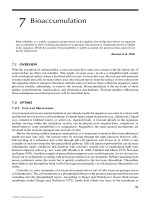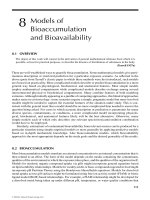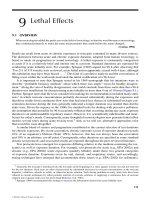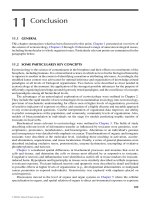ECOTOXICOLOGY: A Comprehensive Treatment - Chapter 19 potx
Bạn đang xem bản rút gọn của tài liệu. Xem và tải ngay bản đầy đủ của tài liệu tại đây (153.23 KB, 5 trang )
Clements: “3357_c019” — 2007/11/9 — 12:43 — page 353 — #1
19
Conclusion
To conceive of it with a total apprehension I must for the thousandth time approach it as something totally
strange.
(Thoreau 1859, cited in Bickman (1999))
19.1 OVERVIEW
This section explored ecotoxicology from the vantage of the population. Detail relative to popu-
lations was provided to enhance the reader’s differentiation and integration of population-related
information. This volume also tries to bridge concepts and techniques in the two sections on organis-
mal and community ecotoxicology. Hopefully, by this initial effort to translate concepts and metrics
among hierarchical levels, consilience might gradually emerge as a more central strategic goal of
ecotoxicology during the next decades.
Let us review for the moment what has been presented in this section. The vantage of population
ecotoxicology, the science of contaminants in the biosphere and their effects on populations, was
argued to be crucial for predicting extinction risk for populations under contaminant exposure. Such
prediction is a central objective of much environmental legislation. With the exception of federal
acts focused on human health or endangered species, the intent of key U.S. environmental laws is an
assurance of speciespopulationviabilityinenvironmentscontainingtoxicants. This can be donemore
directly with population-based concepts and data than with individual-based concepts, models, and
information alone. Potential contributions to the potential effectiveness of prediction can be found in
the subdisciplines of epidemiology, population dynamics, demography, metapopulation biology, life
history theory, and population genetics. Related concepts and techniques afford effective description
and prediction of population consequences.
19.2 SOME PARTICULARLY KEY CONCEPTS
19.2.1 E
PIDEMIOLOGY
Epidemiology provided a mode of describing toxicant-related disease in populations and quantitat-
ively comparing disease in different populations or study groups. Models identifying risk factors for
individuals within populations were described, including proportional hazard, accelerated failure,
and binary logistic regression models. Methods were demonstrated with examples of human disease;
however, they are easily applied to other species.
Results fromepidemiologicalstudies also contribute topredictinggenetic consequences of expos-
ure (i.e., population consequences) as described for mercury-exposed mosquitofish (Chapter 18).
Epidemiological studies also allow convenient estimation of mortality rates applied in simple
population growth models, demographic life tables, and metapopulation models of exposed
populations.
Interpretation of epidemiological results is susceptible to logical errors, so evaluation of results
has to be done thoughtfully. The foundations of causality were quickly reviewed. The intent was
to describe common errors so that they might be avoided and, to borrow a phrase from Alan Watts
(1968), to cultivate a “wisdom of insecurity” about cause–effect relationships. Hill’s aspects of
disease association were explored as a specific set of rules commonly used to improve the process
353
© 2008 by Taylor & Francis Group, LLC
Clements: “3357_c019” — 2007/11/9 — 12:43 — page 354 — #2
354 Ecotoxicology: A Comprehensive Treatment
of identifying disease associations. Hill’s rules are not the only ones relevant to ecotoxicology. The
reader may also want to review those of Fox (1991) and Evans (Evans 1976). Because of the difficulty
in assigning causality, formal Bayesian methods of enhancing belief would be extremely valuable
in epidemiological surveys by ecotoxicologists. General references for Bayesian methods include
Howson and Urbach (1989), Box and Tiao (1992), Retherford and Choe (1993), and Josephson and
Josephson (1996). These methods are useful at all levels of the ecological hierarchy.
The possibility of contaminants influencing the infectious disease process in populations was
explored briefly. The paradigm that toxicants increase the risk of infectious disease by weakening
hosts was judged to be less inclusive than the disease triad paradigm (Figure 13.5). Toxicants, as
components of the environment in which the host and parasite/pathogen are interacting, can favor
either the host or parasite/pathogen. Infectious disease may be fostered or discouraged by exposure
to toxicants.
19.2.2 SIMPLE MODELS OF POPULATION DYNAMICS
Phenomenological models of population dynamics were explored in Chapter 14, assuming a homo-
geneous distribution of identical individuals. They provided important insights despite simplification
and the aggregation of information into basic parameters. Models allowed a clearer understanding
of contaminant influence on the temporal dynamics of populations than afforded by conven-
tional, individual-based methods alone. Some population effects noted during ecological risk
assessments would be inexplicable or only vaguely explicable without such an understanding.
Density-independent mortality due to toxicant exposure was added to classic population growth
models. The possibility of enhanced population productivity (“yield”) as well as reduced productiv-
ity was demonstrated with the incorporation of toxicant exposure into models used to predict yield
for harvested fish and wildlife populations. Methods for estimating population consequences and
time for recovering were described based on these basic models.
19.2.3 METAPOPULATION DYNAMICS
The consequences of uneven distribution of individualsinacontaminatedenvironmentwere explored
with metapopulation models. The risk of local population extinction or lowered carrying capacity
was assessed most accurately with this metapopulation context, a context only now being introduced
into ecotoxicology (O’Connor 1996).
It is crucial to understand the source–sink dynamics of the habitat mosaic populated by a species.
Some poor habitats can contain a number of individuals only if a source habitat is nearby and indi-
viduals move among habitats. Keystone habitats and corridors for migration among segments of the
population become crucial to predicting population consequences of contaminant exposure. Accur-
ate prediction also depends on knowledge of other important population qualities within a landscape
mosaic such as potential propagule rain and rescue effects. The metapopulation context also provides
explanation for toxicant effects to individuals outside of the contaminated area.
19.2.4 THE DEMOGRAPHIC APPROACH
Applying basic demographic techniques, discussion moved beyond phenomenological models to
include heterogeneity among individuals. Lamentably, much of the lethality and reproductive
information currently generated for regulatory purposes—for protecting populations in contam-
inated habitats—is not gathered in a manner directly useful in demographic methods. Despite the
slow evolution of standard methods relative to effectively generating and applying ecotoxicology
data to prediction of population consequences, demographic methods are being used with increasing
frequency in ecotoxicology. Techniques consistent with demographic methods exist for analyzing
toxicological data, for example, the survival time and LTRE (Caswell 1996) methods. Simple and
© 2008 by Taylor & Francis Group, LLC
Clements: “3357_c019” — 2007/11/9 — 12:43 — page 355 — #3
Conclusion 355
matrix-based demographic methods were described and means of including stochastic aspects of
population projections were discussed.
Although applied widely by ecotoxicologists today, the most sensitive stage paradigm was identi-
fied as a false paradigm (weakest link incongruity). Predictions relying on demographic metrics such
as elasticity or reproductive value should replace those based on the most sensitive stage paradigm.
19.2.5 P
HENOGENETICS THEORY
Although emergent properties may confound predictions, life history theory can link contaminant-
related changes in phenotype to population vital rates (Calow and Sibly 1990, Kooijman et al. 1989,
Sibly 1996, Sibly and Calow 1989). The principle of allocation suggests that an individual with
a specific genetic make-up and living in a particular environment must allocate energy resources
so as to maximize Darwinian fitness. Therefore, predictable rules for energy allocation should be
identifiable, albeit expressed slightly differently, for individuals within populations. Shifts in energy
allocation under different environmental conditions produce differences in population vital rates.
For example, a contaminant may require increased energy expenditure for detoxification and repair
of soma in order for an individual to survive to reproductive age. Once arriving at sexual maturity,
that individual might have less energy reserve available for reproduction. Adjustment in the rate
at which an individual becomes reproductively viable might also occur. There could be other life
history changes. Such effects taken together for all individuals in a population result in changes in
vital rates that could result in a change in population vitality or risk of local extinction.
Reaction norms define environment-dependent shifts in phenotype (i.e., phenotypic plasticity).
Reaction norms can be inflexible in which case phenotype does not change once it is expressed.
Some reaction norms can change during the life of an individual. Reaction norms for life his-
tory characteristics allow exploration of toxicant-induced shifts affecting population vital rates
(e.g., Box 16.2).
Polyphenism occurs if an environmental cue triggers expression of one phenotype or another
with no intermediate phenotypes being expressed. Polyphenisms are directly relevant to assessing
effects of endocrine-modifying contaminants on population consequences.As an example, exposure
to an endocrine-modifying contaminant could determine the sex of hatchlings that will make up the
next generation of a turtle population.
Developmental stability is a valuable population-level metric quantifying the ability of individu-
als in a population to develop into a narrow range of phenotypes within a particular environment.
Beyond a certain level of variation, deviations in phenotype expression implies a decrease in fitness
of associated individuals. Metrics such as fluctuating asymmetry allow easy detection of changes in
developmental stability due to contaminant exposure.
19.2.6 P
OPULATION GENETICS:STOCHASTIC PROCESSES
Population genetics can be affected by toxicant exposure. Direct changes to DNA can occur and,
unless repaired, these changes lead to the appearance of mutations. Stochastic processes determining
genetic qualities of populations can also be influenced by contaminants. Contaminants can modify
the spatial distribution of individuals within the population, effective population size, mutation rate,
and migration rate.
Several quantitative tools allow assessment of stochastic consequences to population genetics.
The Hardy–Weinberg principle predicts genotype frequencies if (1) the population is a large, one
of randomly mating individuals, (2) no natural selection is occurring, (3) mutation rates are negli-
gible, and (4) migration rates are negligible. Deviations from Hardy–Weinberg expectations indicate
violation of one or more of these conditions. Models of genetic drift as a function of effective pop-
ulation size allow prediction of genetic change with toxicant-induced reduction in population size.
© 2008 by Taylor & Francis Group, LLC
Clements: “3357_c019” — 2007/11/9 — 12:43 — page 356 — #4
356 Ecotoxicology: A Comprehensive Treatment
Selander’s D statistics quantify the deficiency of heterozygotes. Those deficiencies could be a func-
tion of selection, inbreeding, or population structure (e.g., a Wahlund effect). Wright’s F statistics can
provide understanding of the genetic structure of a population potentially comprised of many demes
or having genetic clines. Insight about normal genetic structure is necessary for properly interpreting
genetic trends seen in field populations. Finally, genetic diversity itself is crucial to the long-term
viability of species populations. Without variation, a population lacks the raw material with which
to adapt to changes in its environment and will eventually disappear when the environment changes.
19.2.7 POPULATION GENETICS:NATURAL SELECTION
Natural selection can be another important process occurring in populations exposed to contaminants.
Natural selection can result in enhanced tolerance, the enhanced ability to cope with toxicants owing
to physiological, biochemical, anatomical, or some other genetically based change in phenotype.
However, natural selection resulting in enhanced tolerance requires genetic variation in the tolerance
trait and populations lacking adequate variability are at higher risk of extinction than those with
adequate variability.
Viability selection is often the focus of tolerance studies; however, other important selection
components can be involved. They include male and female sexual selection, meiotic drive in
heterozygotes, gametic selection in heterozygotes, and fecundity selection. Several selection com-
ponents can occur simultaneously, perhaps resulting in balancing one component against another.
It is important in predicting consequences of toxicant-driven selection that all selection potential
components be assessed carefully.
19.3 CONCLUDING REMARKS
Hopefully, this short treatment of population ecotoxicology has been, simultaneously, informative
and convincing. Several of thekeyconcepts or relationships describedherebroaden one’sunderstand-
ing of toxicant effects in ecological systems. Hopefully, the reader is convinced of the importance
of the population context in scientific and practical ecotoxicology.
REFERENCES
Box, G.E.P. and Tiao, G.C., Bayesian Inference in Statistical Analysis, John Wiley & Sons, New York, 1992.
Calow, P. and Sibly, R.M., A physiological basis of population processes: Ecotoxicological implications, Funct.
Ecol., 4, 283–288, 1990.
Caswell, H., Demography meets ecotoxicology: Untangling the population level effects of toxic substances,
In Ecotoxicology. A Hierarchical Treatment, Newman, M.C. and Jagoe, C.H. (eds.), CRC Press/Lewis
Publishers, Boca Raton, FL, 1996, pp. 255–292.
Evans, A.S., Causation and disease: The Henle–Koch postulates revisited, Yale J. Biol. Med., 49, 175–195,
1976.
Fox, G.A., Practical causal inference for ecoepidemiologists, J. Toxicol. Environ. Health, 33, 359–373, 1991.
Howson, C. and Urbach, P., Scientific Reasoning. The Bayesian Approach, Open Court, La Salle, IL, 1989.
Josephson, J.R. and Josephson, S.G., Abductive Inference. Computation, Philosophy, Technology, Cambridge
University Press, Cambridge, UK, 1996.
Kooijman, S.A.L.M., Van der Hoeven, N., and Van der Werf, D.C., Population consequences of a physiological
model for individuals, Funct. Ecol., 3, 325–336, 1989.
O’Connor, R.J., Toward the incorporation of spatiotemporal dynamics into ecotoxicology, In Population
Dynamics in Ecological Space and Time, Rhodes, O.E., Jr., Chesser, R.K., and Smith, M.H. (eds.),
The University of Chicago Press, Chicago, IL, 1996, pp. 281–317.
Retherford, R.D. and Choe, M.K., Statistical Models for Causal Analysis, John Wiley & Sons, New York, 1993.
© 2008 by Taylor & Francis Group, LLC
Clements: “3357_c019” — 2007/11/9 — 12:43 — page 357 — #5
Conclusion 357
Sibly, R.M., Effects of pollutants on individual life histories and population growth rates, In Ecotoxicology.
A Hierarchical Treatment, Newman, M.C. and Jagoe, C.H. (eds.), CRC Press/Lewis Publishers, Boca
Raton, FL, 1996, pp. 197–223.
Sibly, R.M. and Calow, P., A life-history theory of responses to stress, Biol. J. Linn. Soc., 37, 101–116, 1989.
Thoreau, H.D., 1859. Quote from Henry Thoreau on Education, Bickman, M. (ed.), Houghton Mifflin Co.,
Boston, MA, 1999.
Watts, A.W., The Wisdom of Insecurity, Random House, New York, 1968.
© 2008 by Taylor & Francis Group, LLC
